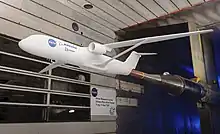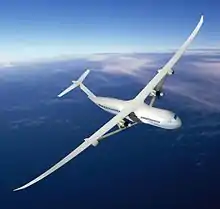Boeing Truss-Braced Wing
Boeing Truss-Braced Wing are airliner designs studied by Boeing with braced, high aspect ratio wings.

SUGAR Volt

SUGAR Volt is a hybrid aircraft concept proposed by a team led by Boeing's Research & Technology division. It is one of a series of concepts put forward in response to a request for proposals for future aircraft issued by NASA. It is proposed that SUGAR Volt would use two hybrid turbofans that burn conventional jet fuel when taking off, then use electric motors to power the engines while flying. SUGAR stands for Subsonic Ultragreen Aircraft Research, the "volt" part of the "SUGAR Volt" name suggests that it would be at least partly powered by electricity.
SUGAR Volt would have emissions about 70 percent lower than average airliners today. Noise pollution will also be lower than airliners today. This hybrid-electric approach however remains to be balanced against increased complexity, large electric engine and battery size and weight. Relying partly on electric power might reduce specific fuel consumption (SFC) compared to a standard turbine-only design (turbofan or lower-consumption turboprops).
SUGAR Volt is designed with a long, braced, high aspect ratio wing that decreases induced drag due to lift. The wings of SUGAR Volt would enable it to take off in a shorter distance and generate less noise. The outer wings of the SUGAR Volt should fold to save ground space, increasing weight.
Transonic Truss-Braced Wing
By early 2019, following extensive wind tunnel testing at NASA Ames Research Center, an optimized truss and more sweep for the 170 ft (52 m) span wing allowed flying higher and faster, up from Mach 0.70–0.75 to Mach 0.80 like current jetliners.[1] Compared to aircraft with cantilevered wings, fuel burn should be reduced by 8-10%, and the technology should be ready in 2030-2035. Aspect ratios up to 27 were evaluated, up from 8-10 for current narrowbodies.[2] The design was presented at the January 2019 AIAA conference and the wing folds outboard of the truss to use airport gates for the 118 ft (36 m)-span 737.[3] (ICAO aerodrome code C)
The wing has 20° of sweep and came forward, the truss was optimised, tapered with an increased root chord, has a trailing edge with forward sweep and generates lift. It should be tested from early 2019 at the NASA Ames 11 ft (3.4 m) transonic tunnel, then later in 2019 at the 14 by 22 ft (4.3 by 6.7 m) subsonic tunnel at NASA Langley. A full-scale X-plane could be developed and tested under NASA’s UEST plan, outlined in the New Aviation Horizons flight demonstration from 2023. Boeing proposed to modify an MD-80 powered by turbofans, but it could test a series/parallel hybrid electric propulsor based on Rolls-Royce LibertyWorks’ EVE concept of a geared turbofan. An 1.5 MW (2,000 hp) electric motor/generator mounted between the compressor and the variable pitch fan, fed by batteries to boost the takeoff and climb, allows for a smaller engine and improves efficiency by 4.5% over a 3,500 nmi (6,500 km) mission. A tail-mounted BLI fan would ingest and reenergize the slow airflow over the fuselage.[4]
References
- "Spreading our wings: Boeing unveils new Transonic Truss-Braced Wing". Boeing. January 8, 2019.
- Jon Hemmerdinger (January 9, 2019). "Boeing unveils trussed wing capable of jet speeds". Flight Global.
- Graham Warwick (January 8, 2019). "Boeing Unveils Refined Truss-Braced-Wing Airliner Concept". Aviation Week Network.
- Guy Norris and Graham Warwick (Jan 11, 2019). "Boeing Refines Truss-Braced-Wing Airliner Concept". Aviation Week & Space Technology.CS1 maint: uses authors parameter (link)
External links
- "Boeing producing battery-powered hybrid plane". Northwest Cable News. August 2, 2010. Archived from the original on January 30, 2013. Retrieved June 18, 2012.
- "Electric aircraft generates buzz at Oshkosh air show". Chicago Tribune. August 1, 2010.
- "Air show examines hybrid airliners". United Press. Aug 2, 2010.
- "NASA, Boeing Test Low-Drag Truss-Braced Wing Concept: High-aspect-ratio, truss-braced wing promises marked fuel savings". Aviation Week & Space Technology. Aviation Week Network. January 27, 2014. Retrieved 10 January 2019.
- Warwick, Graham (January 28, 2014). "Will Boeing Embrace Braced Wings?". Things with Wings Blog. Aviation Week Network. Retrieved 10 January 2019.
- Bradley, Marty (August 2017). "How sweet the future of aviation: An informal brainstorm turns into potential climate-saving flight technologies". Innovation Quarterly. Boeing.
- Droney, Christopher (August 2017). "SUGAR sweetens the deal with Phase 3 results, Phase 4 underway". Innovation Quarterly. Boeing.
- Eric Ting, Kevin W. Reynolds, Nhan T. Nguyen, Joseph Totah (2014). "Aerodynamic Analysis of the Truss-Braced Wing Aircraft Using Vortex-Lattice Superposition Approach" (PDF). 32nd AIAA Applied Aerodynamics Conference. NASA Ames Research Center.CS1 maint: uses authors parameter (link)